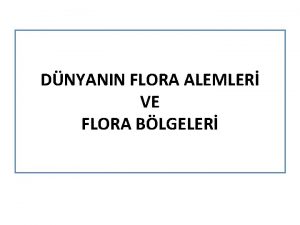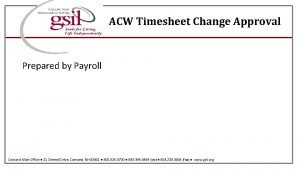Time To Missed Exercise Farrokh Alemi Ph D















- Slides: 15

Time To Missed Exercise Farrokh Alemi, Ph. D.

Why do it? n You need to distinguish between random days of missed exercise from real changes in underlying exercise patterns

Steps in construction of days of missed exercise Verify assumptions 2. Collect data 3. Calculate time to failure 4. Calculate control limits 5. Plot chart 6. Interpret findings 7. Display chart 1.

Step 1: Check assumptions One observation per day n Everyday is a new day. n n Exercise on one day does not affect exercise on other days Successes are more frequent than failures n Longer stretches of missed exercise are more rare n

Step 2: Collect data Decide what is your exercise plan n Keep a diary n Record for each day if you kept to your plans n Keep notes of major changes in your life style n

Step 3: Calculate length of missed plans

Step 4: Calculate control limits R is the ratio of failure days to success days n UCL = R + 3 [R * (1+R)] 0. 5 n

Step 5: Plot control chart X-axis is time n Y-axis is either length of failures n UCL is drawn as straight line n

Steps 6 & 7: Interpret findings & display chart n Any series of failures exceeding UCL cannot be due to chance. n It is a real change in exercise patterns n Display chart n For yourself n For others

Example n n 35 year old female kept daily record of keeping to exercise plans for 18 days First week was preintervention Failures occurred on 2 nd to 4 th, 6 th, 7 th and 16 th day Is she improving?

Calculate length of failures n n n Set to 0 every time we succeed Set to one on first day of failure Increased when more than one consecutive day of failure

Calculate ratio for post intervention period 1 days Number of days of failure =. 10 Ratio = Number of days of success 10 days

Calculate upper control limit UCL= Ratio + 3 * (Ratio*(1+Ratio)). 5 UCL =. 1 + 3 * (. 1*(1. 1)). 5 = 1. 09

Plot chart

Interpret findings & display n n Lots of long failures before the intervention No significant failures since the intervention
 Albizza
Albizza Flora bölgeleri nereleridir
Flora bölgeleri nereleridir Cnler
Cnler Paramesyum pelikula
Paramesyum pelikula Miksotrof canlılar
Miksotrof canlılar Welcome home we missed you
Welcome home we missed you Paylocity forgot password
Paylocity forgot password Missed some points on the visual field test for dvla
Missed some points on the visual field test for dvla Gsil missed punch form
Gsil missed punch form We missed you welcome back
We missed you welcome back Romeo and juliet oh romeo scene
Romeo and juliet oh romeo scene O romeo o romeo
O romeo o romeo Missed connections arlington va
Missed connections arlington va Gsil missed punch form
Gsil missed punch form Kronos workforce timekeeper
Kronos workforce timekeeper Cisco ip phone 7965 voicemail
Cisco ip phone 7965 voicemail





























